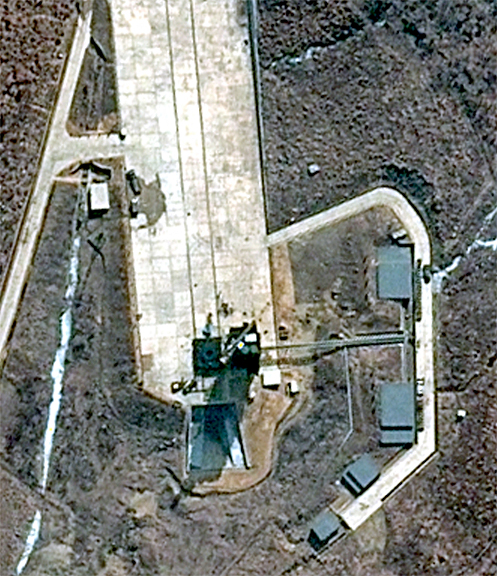
North Korea's Tongchang-dong Space Center's
Sohae Satellite Launching Station.
Image is courtesy of DigitalGlobe.
[Satnews] The Bangkok Post is reporting that North Korea can resume space rocket launches starting with the first quarter of next year, as satellite imagery reveals a three-year upgrade at that nation's main launch site close to completion, this according to researchers.
North Korea insists its space launch program is for scientific use only, while most of the international community insists it is a disguised ballistic missile program that violates UN resolutions. The recent images studied by analysts at the US-Korea Institute at Johns Hopkins University suggested that construction had almost ended with fuel storage bunkers and an engine test stand at the main Sohae Satellite Launching Station. This would appear to mark the end of a three-year upgrade designed to support the testing and launching of "larger" rockets, the institute said on its closely-watched website 38 North.
The Sohae upgrade began in early 2013, with a focus on facilities that could handle larger, longer-range rockets with heavier payloads. North Korea successfully put a satellite into orbit with its Unha-3 carrier in December of 2012. That launch was condemned by the international community as a disguised ballistic missile test and resulted in a tightening of UN sanctions. North Korea is banned under UN Security Council resolutions from carrying out any launch using ballistic missile technology, although repeated small-range missile tests have gone unpunished. The North claims it has developed long-range missiles capable of hitting the US mainland, but many experts say Pyongyang is still years away from obtaining a credible ICBM capability.
The US-Korea Institute believes the completed Sohae upgrade would allow the facility to handle rockets of up to 50 meters (165 feet) in length—bigger than the 30 meter tall Unha-3. However, such a rocket is still believed to be several years from becoming operational, meaning that a repeat Unha-3 launch would be more likely in the short-term.
In a post on its website last week, the institute said separate satellite images suggested North Korea was excavating a new tunnel at its main nuclear test site—there were no indications that a test was imminent, however.

